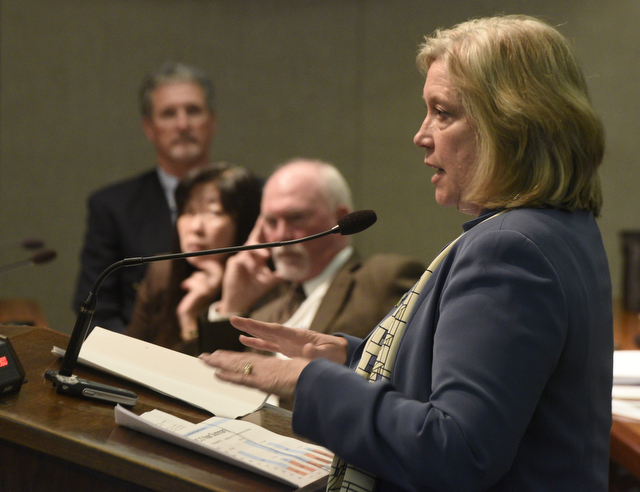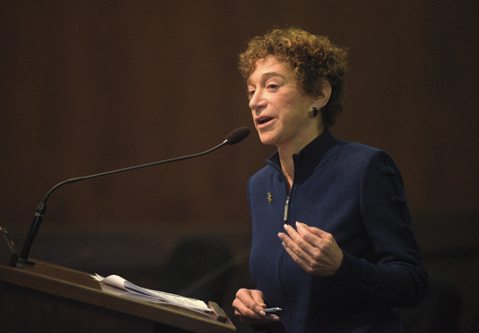‘Black Robe’ Therapy for Mentally Ill Put on Ice
‘Not Yet’ County Supes Tell Supporters of Laura’s Law

The county supervisors didn’t exactly say “no” to Laura’s Law at this Tuesday’s meeting; instead, they said “not yet.” But to supporters of the measure — which would authorize judges to order the most service-resistant mentally ill people into psychiatric treatment — it may have seemed like the same thing.
Tuesday’s vote marked the third time the supervisors have passed on adopting Laura’s Law since the bill was first made law by the State Legislature in 2002. Although the final vote was unanimous, the debate on both sides was uncommonly compelling and suspenseful; prior to the ceremonial final vote, the supervisors were narrowly split 3-2 on how best to proceed.
Leading the charge in favor of Laura’s Law — named after a 19-year-old, former high school valedictorian who was shot to death by a mentally ill man — was District Attorney Joyce Dudley and 3rd District Supervisor Doreen Farr. They cited as their inspiration the deadly carnage inflicted by Elliot Rodger throughout Isla Vista last May.
Dudley and Farr were backed unanimously by the Santa Barbara County Mental Health Commission as well as 12 mental health advocates — mostly mothers — many of whom testified movingly about the challenges they faced raising seriously mentally ill children. Normally such a gathering would have constituted the proverbial irresistible force in Santa Barbara politics. But leading the resistance to the measure was Alice Gleghorn, a formidable, no-nonsense, certified rock star in the field of mental health.

Half a year ago, the County of Santa Barbara hired Gleghorn away from her high-ranking post with the City of San Francisco to save Santa Barbara’s chronically dysfunctional mental health bureaucracy. When Gleghorn finally weighed in with her “not yet,” Laura’s Law was sunk. She described the addition of another responsibility as “too great a strain on the system at this time.”
Gleghorn was specifically hired to carry out an ambitious, desperate, and much deliberated plan to rewire the very DNA of the Department of Alcohol, Drug and Mental Health Services. Since she started four months ago, some notable progress has been made; two temporary housing projects are about to open for those in crisis, one offering 23-hour respite and the other 30-day care. But Gleghorn noted her department has experienced “significant drift” in pursuing some of the reforms she’d been hired to implement. She expressed frustration at how hard it’s proven to hire the 100 new mental health staff authorized by the Board of Supervisors.
Two months ago, Gleghorn sounded the alarm that her department was already $4 million in the hole. That, not coincidentally, is exactly the same amount the county went over budget to ship its most severe psychiatric cases to out-of-county facilities. Santa Barbara’s Psychiatric Health Facility — notoriously oversubscribed — has experienced a dramatic increase in patient demand. Lastly, Gleghorn argued that Laura’s Law also required the county to provide designated patients a broad menu of services that Santa Barbara is currently incapable of providing, chief among them a range of supportive housing options. “We’re entering into an area that does not exist,” she warned.
But for the mental health activists advocating for Laura’s Law, Gleghorn’s lament was just more of the same. They didn’t buy her pitch that she could deliver many of the promises if given time to enact departmental reforms. “It hasn’t been borne out,” said Ann Eldridge, a member of the Mental Health Commission for more than 20 years. Suzanne Riordan of Families Act! said she understood the stress and strain a new program like Laura’s Law could generate among county staff, but added, “Let’s talk about the burden on the people.” Tom Franklin, an activist with the National Alliance on Mental Illness, declared, “It’s a crisis. There are families out there who need the help.”
In a separate interview, Lynne Gibbs, who is active in the mental health community, described how her daughter cycled on and off the street and in and out of hospitals at least 15 times in 12 years because she refused to admit she was mentally ill and, just as adamantly, refused treatment. After her daughter was hospitalized four years ago — at a cost of $150,000 — she was placed under conservatorship of the county Public Guardian at the behest of the Psychiatric Health Facility doctors. Since that court action, Gibbs said, her daughter graduated from Santa Barbara City College, winning the President’s Award for academic excellence. “With treatment under Laura’s Law, I believe she could have taken this path many years earlier,” she said.
What gives Laura’s Law its potency, Gibbs explained, is “the Black Robe Effect” activated when a judge orders otherwise noncompliant mentally ill people into treatment. (In practice, only a tiny percentage of patients ever receive such orders. Most agree to seek treatment “voluntarily” once the process is initiated.) In other counties and other states where similar programs — known as Assisted Outpatient Treatment — are in place, Gibbs said, targeted patients experience a marked reduction in hospitalizations, incarcerations, and homelessness.
If Santa Barbara were to experience the same drop in governmental expenditures generated by such patients as happened in Nevada County — the first in California to embrace Laura’s law — the county would save more than $4 million. County officials are quick to counter that Nevada County is tiny and rural compared to Santa Barbara and can hardly be considered a reliable indicator. Still, administrators acknowledge they would save $62,000 per person per year for Santa Barbara’s top 10 Laura’s Law contenders — people who’ve been hospitalized twice in 36 months for serious mental illness or jailed once in 48 months for a violent offense — and $50,000 per person per year for the top 75.
These savings, however, assume that the full complement of “wrap-around” services called for under Laura’s Law are in place and in effect. Currently, they are neither. Skeptics of Laura’s Law insist there’s no evidence to substantiate the persuasive powers attributed to judicial intervention; they insist studies demonstrate the same benefits can be derived without getting the courts involved. Lynne Gibbs isn’t buying it. “With Laura’s Law, county mental health must treat them,” she said. “They can’t be ignored just because they don’t come into an office seeking treatment.”
On the table was a full-fledged Laura’s Law effort targeting 75 individuals that would have cost $2.2 million a year and a cheaper, smaller three-year pilot project that would have involved only 10 individuals at a cost of $630,000. Despite the insistence of almost everyone to the contrary, money is an issue. The reason that many counties throughout California are now adopting Laura’s Law is because in 2013, the State Legislature passed a bill allowing such programs to be paid for with proceeds of Proposition 63, the 2004 statewide ballot initiative imposing a tax on millionaires to fund mental health programs.
Earlier this year, Santa Barbara County mental health officials concluded an exhaustive community deliberation to divvy up those funds. Even if the supervisors adopted the 10-person pilot program, that money would have to be taken from a mental health initiative that’s already been funded. The supervisors voted to revisit the issue of Laura’s Law later, but only after examining the progress Gleghorn has made in reforming her department sometime within the year. Supervisors Doreen Farr and Salud Carbajal supported enacting Laura’s law. Supervisors Steve Lavagnino, Peter Adam, and Janet Wolf voted against.



